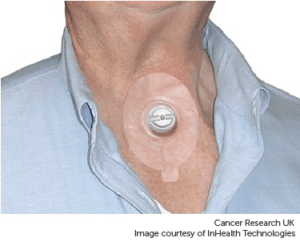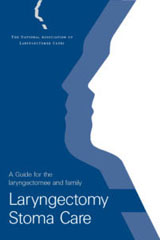Your stoma is now your airway. You breathe and cough through it. It is very important that you know how to look after it.
Learning to care for your stoma is an essential part of the recovery process after a laryngectomy. The stoma opening can introduce bacteria and viruses into your body that can lead to infection. Proper care can limit this type of complication.
Protecting your stoma
Before your surgery, the air reaching your lungs was warmed, moistened and cleaned as it passed through your nose and upper airways. When you breathe in through your stoma, the air is drier and colder than your lungs are used to. It may also contain particles of dust. All this can irritate your lungs.
The dry air can make your airways produce mucus. The mucus can collect around your stoma and get crusty. To protect your stoma and your airways, try to avoid:
- extreme temperatures
- fumes from traffic or work places
- smoke
- dust
This can be hard to manage if you live in a town or city. But there are other ways to protect your lungs after a tracheostomy or laryngectomy.
Keeping your airway moist
The air you breathe through the stoma goes directly into your lungs through the laryngectomy or tracheostomy tube. It is no longer moistened as it passes through your mouth and nose.
This means the moisture must be replaced. If it isn’t, the mucus your airways naturally produce becomes thick. This can make it difficult for you to breathe.
If your mucus becomes so thick that you can’t cough, this can be very serious. It can potentially block your stoma. It can also make you more likely to get chest infections.
There are things you can do to help to avoid these problems:
- drink at least 2 litres of fluids each day to help keep the mucus in your airways thin
- spray sterile salt solution (saline) directly into your tube to keep it clean and moist (your nurse can show you how and when to do this)
- use a filtering and moistening system
- use humidifiers in your home
Filtering and moistening systems
Some people use filtering and moistening systems. Some manufacturers call these systems HMEs (it stands for heat and moisture exchangers). You can look out for this term when you look for suppliers.
Your stoma nurse can tell you about the different types of filtering and moistening systems. They can be:
- a piece of foam you wear over your stoma and spray with water
- a more complex system that fits over your stoma to clean and moisten the air you breathe
The piece of foam is the simplest and most convenient method of moistening the air you breathe.
 There are custom made laryngectomy foams with ties that go round your neck. These are sometimes called stoma bibs. They come in a variety of styles and cover your stoma.
There are custom made laryngectomy foams with ties that go round your neck. These are sometimes called stoma bibs. They come in a variety of styles and cover your stoma.
Covering your stoma helps to keep out dust, pollen and other objects. As a result, your stoma will be cleaner, with less crusting, and you will probably have fewer infections.
Coughing can help clear your stoma of mucus. If you’re not strong enough to cough forcefully, you may need to manually suction out the stoma. Your healthcare provider can show you how to suction properly so as not to cause infection.
Humid air helps prevent crusting of the stoma. Use a humidifier in your home, especially in your bedroom at night. Your doctor might recommend you use a special mask that delivers humidified air directly to your stoma for a period of time. This is more common when a stoma is new. Once the skin around your stoma “matures,” or becomes used to the dry air, you’ll no longer need the mask.
Skin care around your stoma
You need to clean your stoma often while it is healing. When you are in hospital, your nurse will help you do this.
The liquid recommended for cleaning stomas and tubes varies between hospitals and specialists. Your stoma nurse or ENT surgeon may suggest sterile water, sterile salt solution or a mild antiseptic.
Your stoma might need cleaning 4 or 5 times a day until it has completely healed. Keeping your stoma clean can help to stop scar tissue from forming. Scar tissue can make the stoma narrower.
When the skin has healed, you can use soap and water to clean round the stoma. Be careful not to get any soap into the stoma as it might irritate the skin.
Remember always to dry your skin thoroughly. Your doctor might give you an antibiotic cream to put on the skin around your stoma. But not everyone needs this.
All the tubes and speech valves need regular cleaning. Your speech valve might come with specially designed brushes or sprays to help you clean it. Because the valve connects your windpipe with your food pipe, food can lodge around it. If you don’t get rid of these, they can block the valve or cause an infection.
Before you leave hospital, your nurse will advise you to clean the valves once a day. They show you how to take out the valve, clean it and put it back. Your stoma nurse might also help you at home. As your confidence grows, you will manage this yourself.
Cleaning and changing your larry tube
Many people learn to clean and change their own tubes. You will not be expected to do this until you feel confident and have practised with your nurses before leaving hospital.
You might need to clean your tube every day or only once a week. If you have a double cannula tube (with an outer and inner tube), you should clean it between 3 to 5 times a day. Some people clean their tubes more often. When you are not cleaning it, your inner tube should always be in place (inside the outer tube of your stoma).
To change and clean your tube at home, you might need:
- brushes
- swabs to clean around your stoma
- cotton ties to secure the tubes
- a mirror so you can see what you are doing
How you clean the tubes varies, depending on the type of tube you have. Your nurse shows you how to do it before you leave hospital. You can also practise on the ward, with a nurse watching you and giving you support.
At first, taking out your tube might feel terrifying. But your stoma will heal so that it’s permanently open. Once you are confident, you will find it easy to do.
Download a free Stoma Guide Leaflet – HERE

